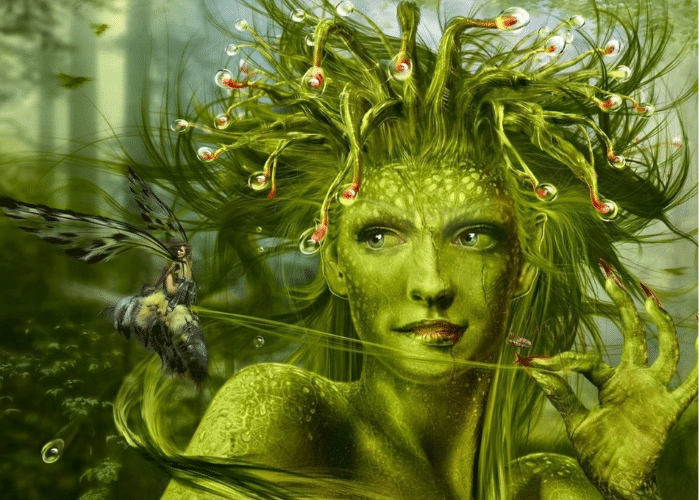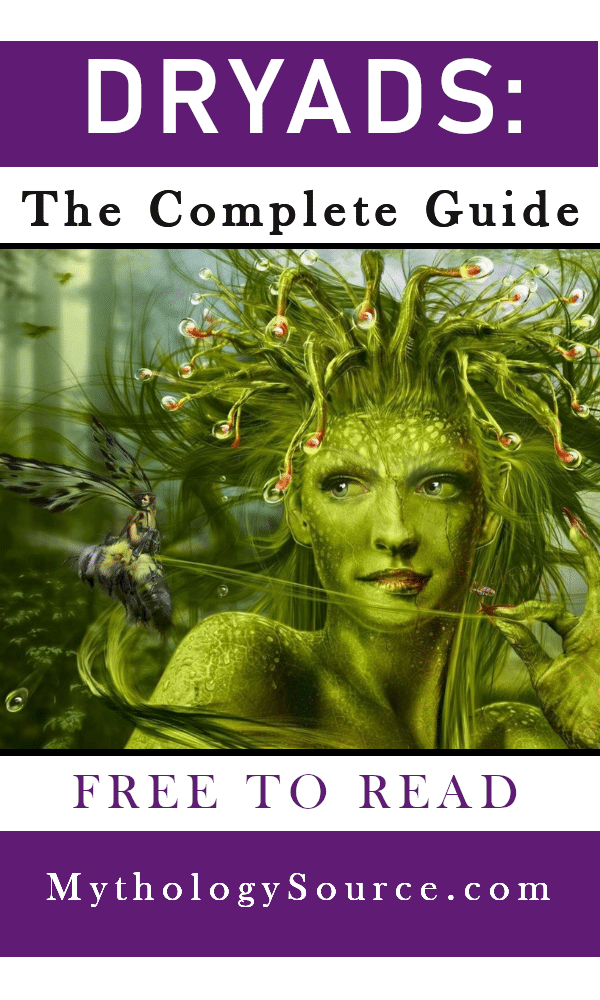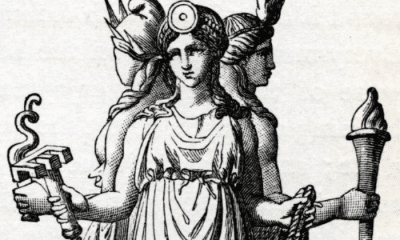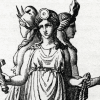
Greek
Dryads: The Nymphs of the Trees
Dryads: The Nymphs of the Trees
The Greeks believed that nature was positively alive with the spirits that resided there. Read on to learn all about the dryads, the beautiful nymphs that lived among the trees!
In the Greek world, nymphs were everywhere. They were nature goddesses and, even if they were rarely ever seen by humans, they could be found in all the places that trees grew, water ran, wind blew, animals flourished, and mountains soared.
Like most nymphs, the dryads were beautiful young women who inspired great love among mortals and gods alike.
Unlike most other nymphs, though, you did not have to be born a dryad to become a spirit of the trees.
The dryads were some of the most famous nymphs of Greek mythology. They were wives, lovers, mothers, companions, and caretakers to gods and men alike.
The Dryad Nymphs
The Dryads were one of the many types of nymphs in Greek lore.
The nymphs were minor goddesses, usually tied to a specific place. They represented natural features like bodies of water, islands, or mountains.
Nymphs were everywhere in the Greek view of the world. Almost everything in the landscape could have a living goddess attached to it.
As goddesses, most nymphs had some supernatural abilities and their lifespans, while not always immortal, were far longer than those of humans. Their powers were more limited, though, than those of the more major gods.
Among these, the dryads were specifically the nymphs of the trees.
The Greek word drys meant “oak” and the term dryad initially only applied to those nymphs who were spirits of oak trees. In time, however, the word became a term for all tree nymphs regardless of the type of tree they inhabited.
Nymphs were thought to occur throughout the natural world, but they often hid from humans. When they were seen they were described as beautiful young maidens who were graceful, but occasionally a bit wild.
Nymphs did not belong to the cultured cities of the Greek world. They were spirits of the wilderness. Share on XGreek culture, in fact, ensured that the dryads were far removed from most aspects of daily life. Cultivation had cleared the forests in the valleys and plains of Greece, so most forests remained only on the rugged mountainsides.
As spirits who were far removed from interaction with most people, the dryads were often shy. Their wild nature showed, however, when some of them joined in the revelries of Dionysus.
The dryads and other nymphs were known to be fond of dancing, but never came out to do so unless they knew the coast was clear.
Their male counterparts were the rustic gods such as Pan and the satyrs. The female nymphs were more refined and graceful than the wild, bestial male spirits but often joined them in their wild exploits.
The two groups of deities were often linked together, both culturally and romantically. At other times, however, the rustic gods posed a threat to the physical safety of the dryads and other nymphs.
The Companions of Artemis
Nymphs, especially dryads, were hard to find in the ancient world. Although they existed everywhere in nature, they preferred to stay away from humans.
They also avoided most of the gods. Greek mythology is full of stories of nymphs being chased and attacked by lustful gods, so they often preferred to stay out of sight.
The one major exception to this was Artemis.
The goddess of hunting, Artemis was a great friend to the nymphs. Her entire retinue was made up of nymphs who, like her, preferred running through the forest to the rules and limitations of life on Mount Olympus.
As an avowed virgin, Artemis also used her strength as an Olympian to protect the weaker nymphs from unwanted advances by both humans and gods. Most of her companions took a similar vow of celibacy, although a few of the dryads and naiads with her left to get married.
The dryads were her closest companions, joining her in her hunts and living happily in the forest. Their protective goddess kept them safer, while they provided her with companionship that was more to her likely than that of the other Olympian goddesses.
Becoming a Dryad
In addition to the nymphs who were born as the spirits of trees, there was another group of dryads. These were usually nymphs as well, although they did not begin their lives bound to vegetation.
Many nymphs in Greek mythology were turned into trees and, thus, transformed into dryads.
This was often done at the nymph’s request, usually through the powers of Gaia.
The Mother Earth was protective of her children, and as goddesses who were connected to nature the nymphs had a particularly close bond with her.
A few nymphs underwent the transformation into dryads to spare them from heartache or emotional pain. Share on XThe Heliades, for example, were daughters of the sun god Helios. They were so overcome with grief when their younger brother was killed that Gaia transformed them into a grove of poplar trees to end their grief.
Most, however, were transformed as a means of escape.
Not all nymphs of the forest were protected by Artemis. Some found themselves running from the advances of amorous gods and men with little hope of escape.
They were turned into trees to spare them the shame and pain of being caught by these men.
One of the most famous of these transformations was that of Daphne. She became a laurel tree when Apollo, as a result of a trick played by Eros, went mad with love for her.
Pitys became a pine tree while fleeing from one of the rustic gods. Syceus, a Titaness, was transformed into the first fig tree to escape unwanted attention from Zeus.
It wasn’t just nymphs and Titanesses who could be turned into dryads. The story of Dryope was one of a human who was transformed by the dryads she had befriended.
Dryope had befriended the nymphs while she tended to her father’s flocks. The friendship had earned the attention of Apollo, and she gave birth to his son.
When her son was grown and became king, the dryads she had known in her youth came to her in the forest again.
Dryope was changed from mortal to Nymphe. Amphissos, in honour of the favour shown to his mother, set up a shrine to the Nymphai and was the first to inaugurate a foot-race there. To this day local people maintain this race. It is not holy for women to be present there because some maidens told local people that Dryope had been snatched away by Nymphai. The Nymphai were angry at this and turned the maidens into pines.
-Antoninus Liberalis, Metamorphoses 32 (trans. Celoria)
In the story of Dryopes, the transformation from human to dryad was a great gift. For the girls who spread false stories about her, however, it was a punishment.
For those who were turned into dryads, their transformation into a tree kept them safe. Whether from their own suffering or from dangerous men, the dryads were safe as trees.
The Classes of the Tree Nymphs
While the term Dryad generally applies to tree nymphs, there were actually several types of these.
- The Meliae were ash tree nymphs. They married men of the Silver Age, before the first woman was created, and became the maternal ancestors of all of mankind.
- The Oreads were the spirits of mountain conifers. In addition to their trees, they came to represent the mountains themselves.
- The Hamadryads were oak and poplar trees. Unlike some of the other classes of dryads, they were usually connected to their tree and rooted in place.
- The Meliades were both fruit tree goddesses and protectors of sheep, as the Greek word melas meant both “sheep” and “apple.” The Hesperides who guarded the golden apples of Hera were Meliades.
- Daphnaei were laurel tree dryads. They took their name from Daphne, the first of their kid.
- Ampeloi were grapevine goddesses. They were particularly important in the wine-growing regions of the Mediterranean.
Many specific types of species of trees had their own class of dryads. They tended, like the trees they represented, to congregate in groups of a similar type.
Sacred Trees and the Dryads
The Hamadryads were the most numerous and well-known of the tree nymphs. The spirits of oak and poplar trees, they were found throughout Greece.
The oaks in particular were more likely to grow away from others of their kind. Both they and the poplars were often found closer to humans and on the edges of rivers.
The Hamadryads were noteworthy for the fact that, unlike many of the other nymphs, their lives were bound to an individual tree.
Other dryads watched over the trees that grew in a particular grove or area. When one tree fell, there were others nearby.
The solitary Hamadryads of the oak trees, however, did not have that security. If their tree was killed or cut down, their own life would end.
Because of this, the gods inflicted harsh punishment on anyone who cut down or otherwise endangered a sacred tree. To fell an oak that housed a Hamadryad was not only a violation of the gods’ laws, but it was also a form of murder.
Of course, it wasn’t just humans that posed a risk to the Hamadryads.
Chrysopeleia was an oak nymph whose tree grew by a fast-moving river. When the river flooded, her tree was in danger of being uprooted and destroyed.
The hunter Arcas saw the danger and sprang into action. He rerouted the river and quickly built a dam to protect the sacred oak from the rising water.
Chrysopeleia was so impressed by the hunter’s quick action on her behalf that she fell in love with him and had two sons. Arcas himself later became King Arcas, the founder of Arcadia.
The Nurses of the King
The dryads were known to be caring, motherly beings. They were generally kind, particularly to those in need.
One of the most well-known examples of the caring nature of the dryads is the Meliae.
They were ash tree nymphs, although Hesiod implied that the word could be used for any tree spirit. Unlike many of their fellow dryads, however, they were not born from the lesser gods.
The Meliae were daughters of Gaia herself. After her husband, Uranus, had been castrated Gaia used his blood to give birth to the first tree nymphs.
After Chronos took power as the king of the Titans, Rhea asked the Meliae for their aid.
Chronos had been eating each of Rhea’s children moments after birth, driven by fear of a prophecy that said he would one day be overthrown by one of his own sons. Rhea and Gaia had devised a plan to deliver her sixth child in secret, but they would need someone to foster the baby.
When Zeus was born, the Meliae took him in. They hid him in the mountains of Crete, feeding him goat’s milk and honey until he grew strong enough to challenge his father.
The Meliae were not just maternal toward their foster son. According to some sources, they went on to be the ancestors of the men who lived during the Bronze Age.
The Agency of the Dryads
The Greeks believed that the nymphs were almost infinite in number. There were thousands of woodland deities that watched over every part of the natural world.
The dryads, like most other nymphs, were regarded as lesser goddesses. Their powers were limited and they were bound to one place on the physical earth.
They believed, however, the the dryads were actually very powerful in their own way.
While the dryads could not wield great weapons or perform amazing feats of magic and strength, they touched the lives of the Greek people in a very important way. Share on XThe awe that people felt when they looked at nature was not, to the Greeks, a product of the human mind itself. The peace that came from sitting beneath a tree on a pleasant afternoon and even the terror felt in a dark forest at night were also not random emotions.
The ability to inspire strong emotions was the gift of the dryads. Everywhere they and their fellow nymphs existed, they were able to touch humans with this gift.
The strong emotions invoked by nature could be dangerous, as many nymphs learned when men and gods turned violent and possessive toward them. But the dryads could also inspire feelings of peace, joy, wonderment, and awe.
To summarise, the dryads were tree nymphs that often hid themselves away from men and gods. They could be born as nymphs or be transformed into them, but the many types of dryads made the forest a sacred place that inspired emotions in mankind.




